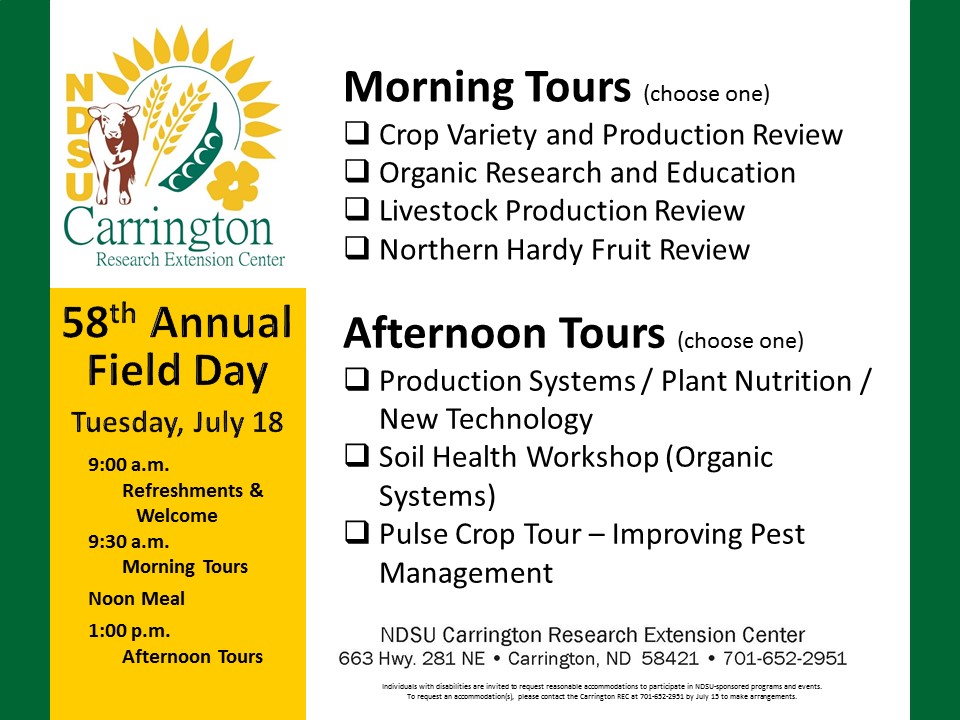2017
References for Choosing Cover Crops Based on Herbicide Residues in Soil
With harvest in progress, there will be the opportunity to plant cover crops during late summer for numerous reasons including soil protection and increasing soil productivity. One of the many criteria to consider when choosing cover crops is a likely restriction with previously applied herbicides. With most herbicides, there is a waiting period between application and planting a new crop, including cover crops. The following are several references to aid in selecting cover crops based on herbicide restrictions.
- 2017 North Dakota Weed Control Guide: Pages 102-103 contain a chart showing crop rotation restrictions for numerous herbicides and crops. Also, on page 105 is information on herbicide residue and fall cover crop establishment.
- ND cover crop tolerance to previously applied wheat herbicides: The research to build this database began in 2016 at three NDSU locations and continues in 2017. The 2016 data includes the relative tolerance (low, medium or high damage) of nine crops (radish, turnip, beet, field pea, lentil, flax, oat, barley and rape) to nine commonly used wheat herbicides. The data can be obtained by contacting the Carrington REC.
- Herbicide rotation restrictions in forage and cover cropping systems: Includes tables that list months to plant forage crops (non-legume and legume) after herbicide application on small grain, corn and soybean. http://ipcm.wisc.edu/download/pubsPM/Herbicide-Rotation-Restrictions_FINAL.pdf
- Managing risk when using herbicides and cover crops in corn and soybean. www.extension.umn.edu/agriculture/weeds/herbicides/docs/cover-crops-and-herbicides.pdf
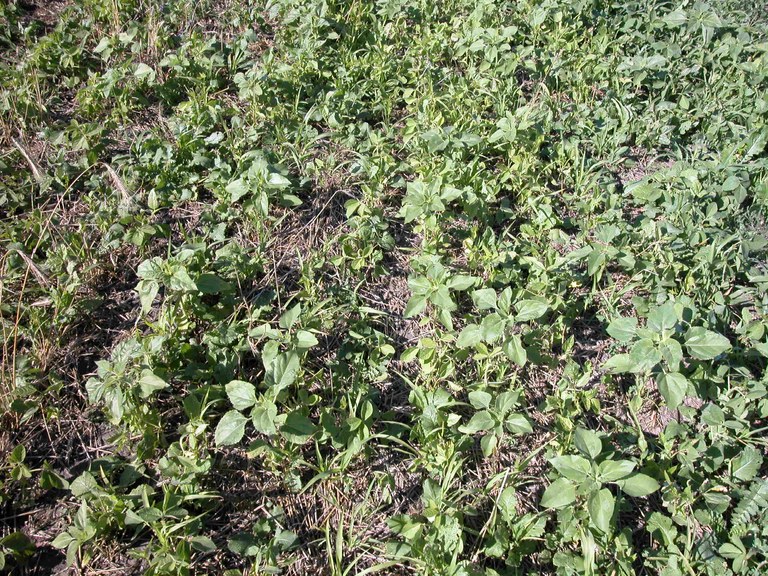 Growing cover crop mixture.
Growing cover crop mixture.
2017 Nutrient Management Day
Registration opens TUESDAY, AUGUST 1st
www.tinyurl.com/crecstore
or
https://epayment.ndus.nodak.edu/C22800_ustores/web/store_main.jsp?STOREID=29&SINGLESTORE=true.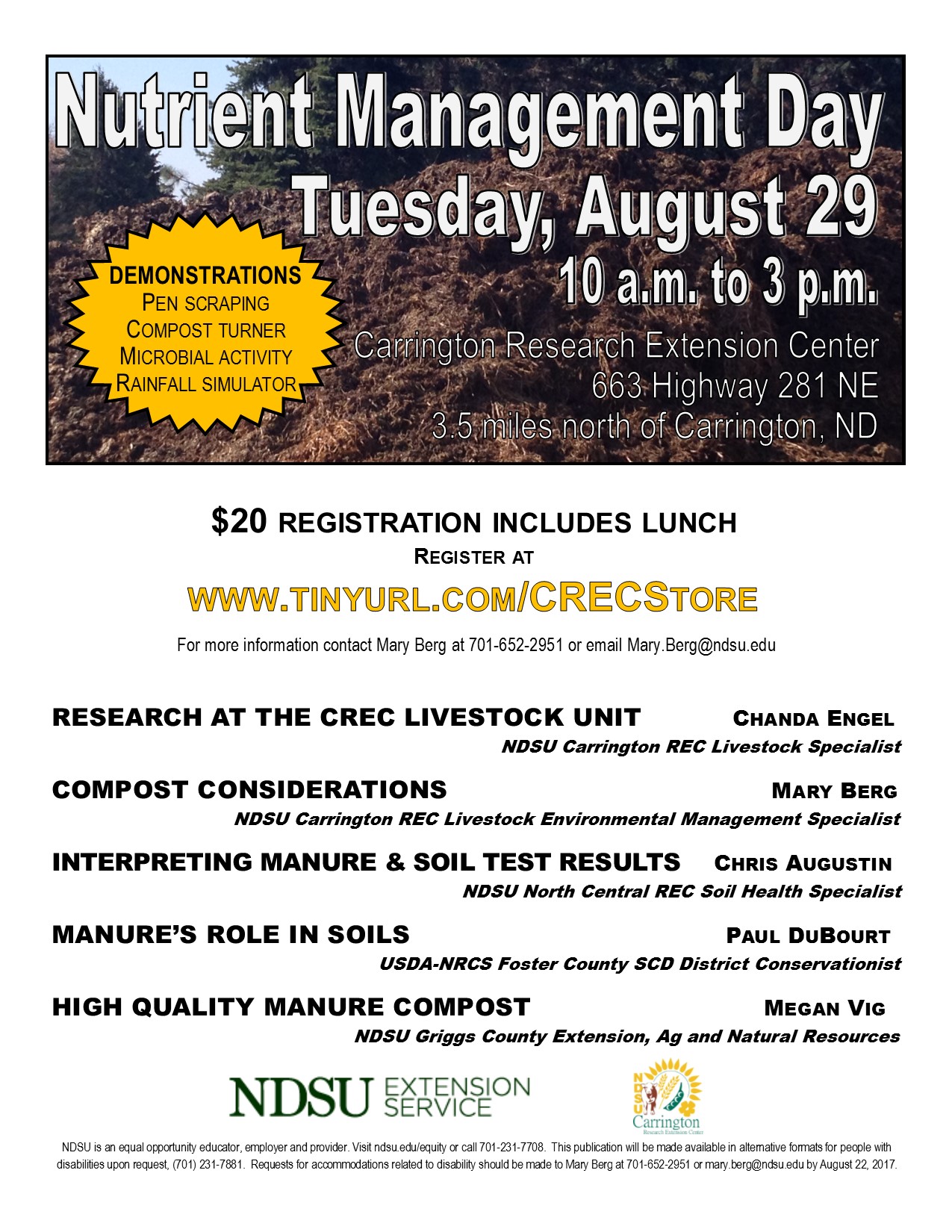
In a Drought? --- Go drylot for the cows!
The Carrington Research Extension Center has a cow calf herd that has been in drylot for over 30 years. They don’t go to grass pasture.
If ranchers are considering options during a drought when the pasture or range is almost grazed off, they can consider drylotting, the cows. Drylotting refers to raising or feeding cattle in a pen where feed, water and bedding are provided to the cattle. Cows and calves are fed a nutritionally balanced ration every day. Drylotting works extremely well: a visit to the CREC Livestock Unit provides visual proof that management and feeding skills are available to maintain a productive cow-calf herd.
The CREC cow herd is used for numerous feeding trials. Retired Animal Scientist Vern Anderson researched many co-product feeds during his tenure at the center. These co-product feeds – like wheat midds, distillers grains, barley malt sprouts, beet pulp - are produced in North Dakota and are now widely used in cattle rations. These feedstuffs are currently available during this year’s drought. For listing of coproduct produced in North Dakota go to: https://www.ag.ndsu.edu/drought/feeds-and-feeding/sources-and-prices-for-selected-co-products-produced-in-nd.
Calf weaning weights and cow pregnancy rates are similar to pastured cattle if the ration for the drylot cow herd is matched to the cows and calves’ production needs.
Anderson and coworkers reported on a comparison of the CREC cow herd when drylotted or taken to pasture for 6 months over a 3 year period. Conception rates were similar between drylot or pasture fed cows. Calf weights were lighter for the drylot cows however, drylot cows also lost more weight that the pasture cows during lactation. This suggests that the ration provided to the drylot cows in this experiment contained less available energy and other nutrients than the pasture grazed cattle. To review the report go to: https://www.ag.ndsu.edu/CarringtonREC/documents/livestockrd/docs2013/2013-drylot-vs-pasture-beef-cow-calf-production-3-year-progress-report/view.
Feeding cows and calves in drylot had a higher cost as compared to pasture costs during this study that was conducted in a non-drought weather cycle. However, during a drought when pasture is not available, the alternative is to sell cows, feed cows on pasture, or feed cows in drylot.
The CREC's cow herd is a good example of alternative management for cow herds. Excellent information to consider during a drought.
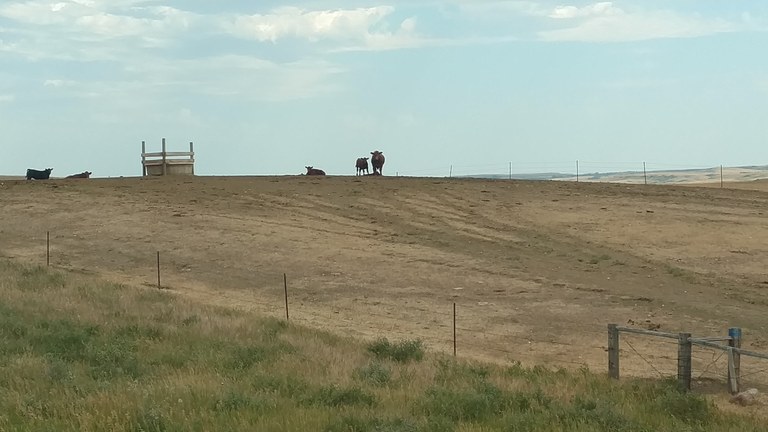
If your pasture looks like this, it’s time to consider drylot feeding management.
Karl Hoppe, Ph. D.
Karl.Hoppe@ndsu.edu
Area Extension Livestock Specialist
58th Annual CREC Field Day
The Carrington REC will host our 58th Annual Field Day on July 18. We gather at 9:00 a.m. in the main yard for refreshments and a welcome from Center Director Blaine Schatz and Dr. Ken Grafton, VP for Agriculture, Dean and Director of the NDSU Ag Experiment Station. Tour wagons leave the yard at 9:30 a.m.
Participants will choose from four tours in the morning:
- Crop Variety and Research Review: Review cultivars of spring wheat, dry beans and soybeans. Research project updates addressing spring wheat, corn, soybean, dry bean, canola and carinata.
- Livestock Production: We’ve had our eye on rye: rye silage for feedlot cattle, double cropping rye with barley as forage, and swath grazing millet after rye harvest. Additional topics will include the NDSU Extension Service’s corn silage sampling project, creep feeding drylot cow/calf pairs, feed additives that enhance rumen fermentation, and a demonstration to determine adequate feed mixing time.
- Organic Research and Education: A focus on oats includes variety development, production practices, research reviews, growing forage oats and marketing oats in local markets. Other topics include a chef’s perspective of local and organic grain use and cereal grains for local craft use.
- Northern Hardy Fruit Project: A walking tour of the orchard and an on-site discussion about native pollinators in the orchard.
A complimentary noon meal will be served and afternoon programs continue at 1:00 p.m.
Afternoon events include (choose one):
- Production Systems/Plant Nutrition/New Technology: A rolling tour of practical applications for UAVs, soybean weed management traits, rye cover crop for soybean and dry bean, industrial hemp, sensor-based N for wheat and corn, P impact on wheat varieties, and integrating cover crops and beef production.
- Soil Health Workshop: This indoor workshop will focus on organic systems with topics including livestock, cover crops, no-till, weed ecology, NRCS, and field and garden production effects on soil health.
- Pulse Crop Tour - Improving Pest Management: Weed and insect management recommendations, disease research, root diseases in field peas and lentils, improving fungicide deposition, management of ascochyta in chickpea, and foliar disease control in field pea and lentil.
Other:
- Forty species of northern hardy trees and shrubs are available for inspection year-round at the CREC Arboretum. Self-guided walking maps are available.
- The CREC’s weed arboretum contains about 60 weeds arranged in groups including North Dakota noxious weeds, perennials, biennials, annual or winter annual grasses, annual broadleaves and winter annual broadleaves, all identified with labels.
Our annual Field Days are free and open to the public. No registration is required. The Carrington Research Extension Center is located 3.5 miles north of Carrington on Highway 281. Call 701-652-2951 with questions.
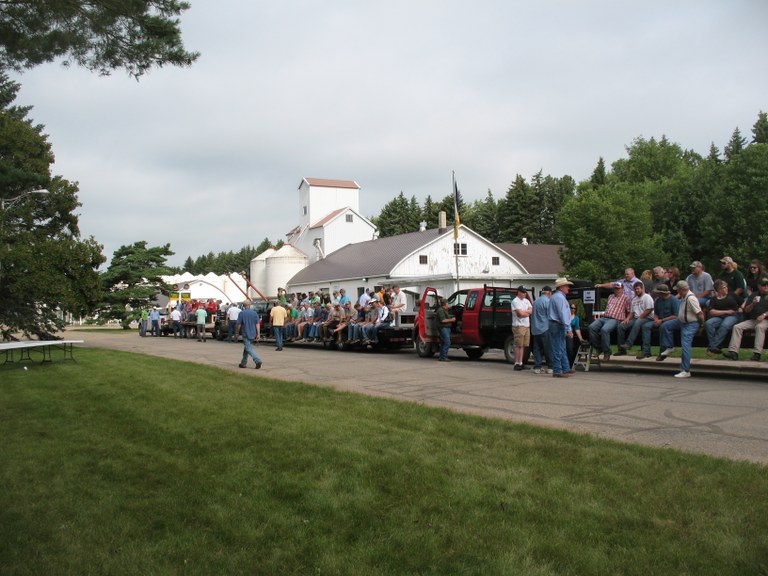
Extending Grazing Forage Supply: Supplement for substitution
The current dry conditions affecting a large area of North Dakota this year have cattle producers evaluating various management options to reduce the need for herd reduction. Potential options to consider include early weaning, limit-feeding, and targeted culling. Consideration should be given to all potential options; however, an immediate strategy may be trying to extend the currently available forage supply through feeding by-product feeds and or grains to grazing cattle.
In situations when forage supply is adequate but quality is suffering, supplementation, especially with protein supplements, can increase dry matter intake of grazed forages. However, when forage supply is limited, providing alternative feed sources to grazing cattle may cause a substitution response and help extend the forage supply.
A considerable variety of by-product feedstuffs and grains are produced in North Dakota (https://www.ag.ndsu.edu/publications/livestock/alternative-feeds-for-ruminants). The cost of these feeds can vary and should be evaluated on a cost per pound of nutrient supplied when deciding which will be the most cost effective (link to Combined Feed Value and Protein and Energy Calculator).
Ideally, choosing a by-product source low in starch and high in digestible fiber will provide the greatest substitution benefit as starch can negatively impact fiber digestion. Hand feeding, cake boxes, or grain tanks may be viable options for daily delivery. If daily delivery is not feasible then a self-feeder can be used. However, a limiting agent such as salt should be included to prevent over consumption.
A considerable amount of research has been conducted to evaluate dry distillers grains (DDGS) as a feed option to effectively substitute for forage. A review of 20 studies utilizing growing steers and heifers determined that as level of DDGS offered increased, the average daily gain linearly increased while forage intake decreased quadratically (figure 1 and 2). The amount of forage replaced per pound of distillers ranged from .28 to 0.50 lbs forage/lb DDGS.
Figure 1. Average daily gain response of growing steers and heifers fed increasing levels of DDGS
Adapted from Griffin et. al., The Professional Animal Scientist 28 (2012):306-312.
Figure 2. Forage replacement in diets of growing steers and heifers fed increasing levels of DDGS
Adapted from Griffin et. al., The Professional Animal Scientist 28 (2012):306-312.
When considering your supplemental feed options price should be the greatest decision driver. In general, higher levels of supplemental feed will result in greater forage replacement.
Chanda Engel
chanda.engel@ndsu.edu
Livestock Research Specialist
How Can You Use Your Drone Around Your Farm?
To comply with FAA small UAS rule (14 CFR part 107), anyone who wishes to fly a drone for work or business is required to obtain a Remote Pilot Certificate. You can find more information about becoming a certified remote pilot here https://www.faa.gov/uas/getting_started/fly_for_work_business/becoming_a_pilot/.
So, you have a drone. How can you use it around your farm?
Maybe you can start by taking a picture of your farmstead.
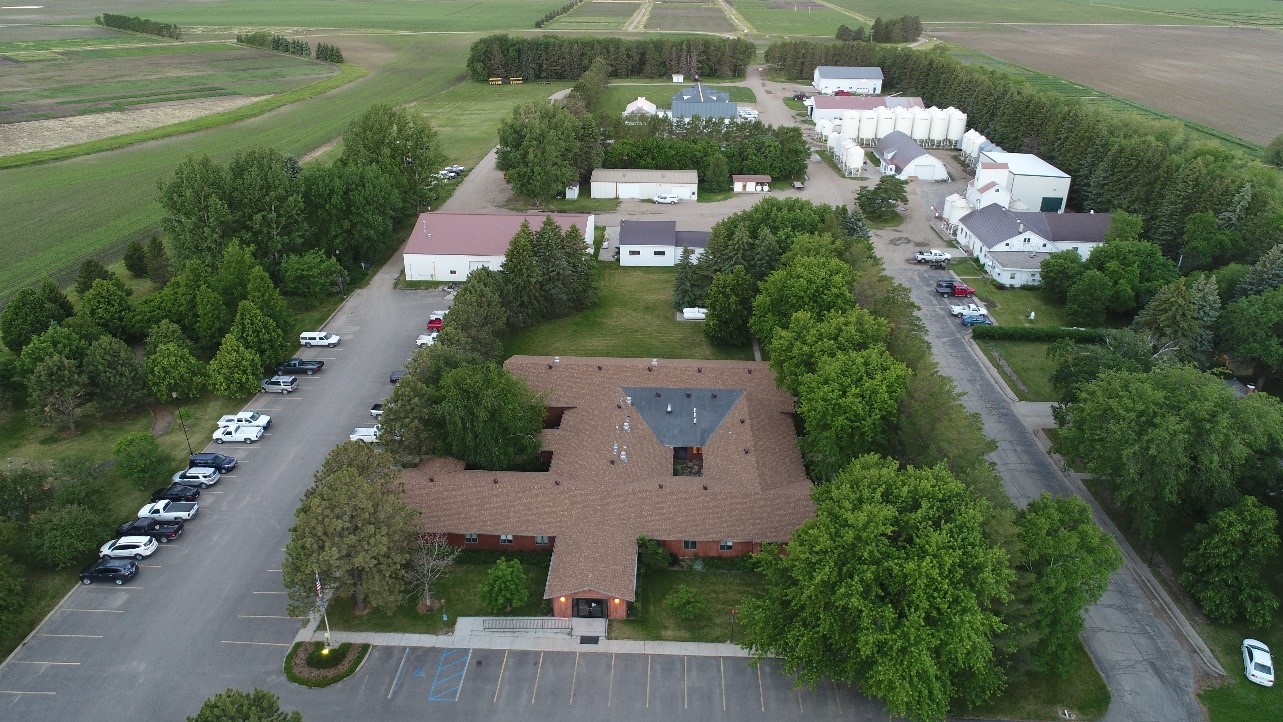 Carrington Research Center headquarters. Altitude around 250ft above ground.
Carrington Research Center headquarters. Altitude around 250ft above ground.
Maybe you are just interested in a general view of your fields.
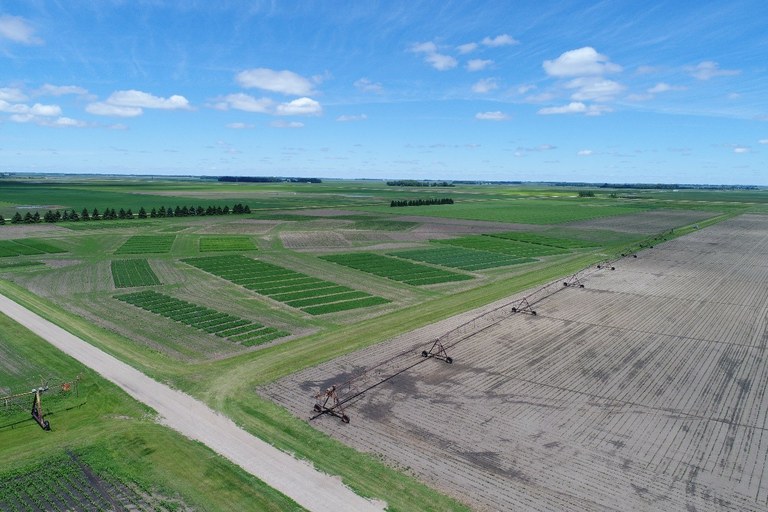
How about taking a look at your fields’ drainage after a rain event?
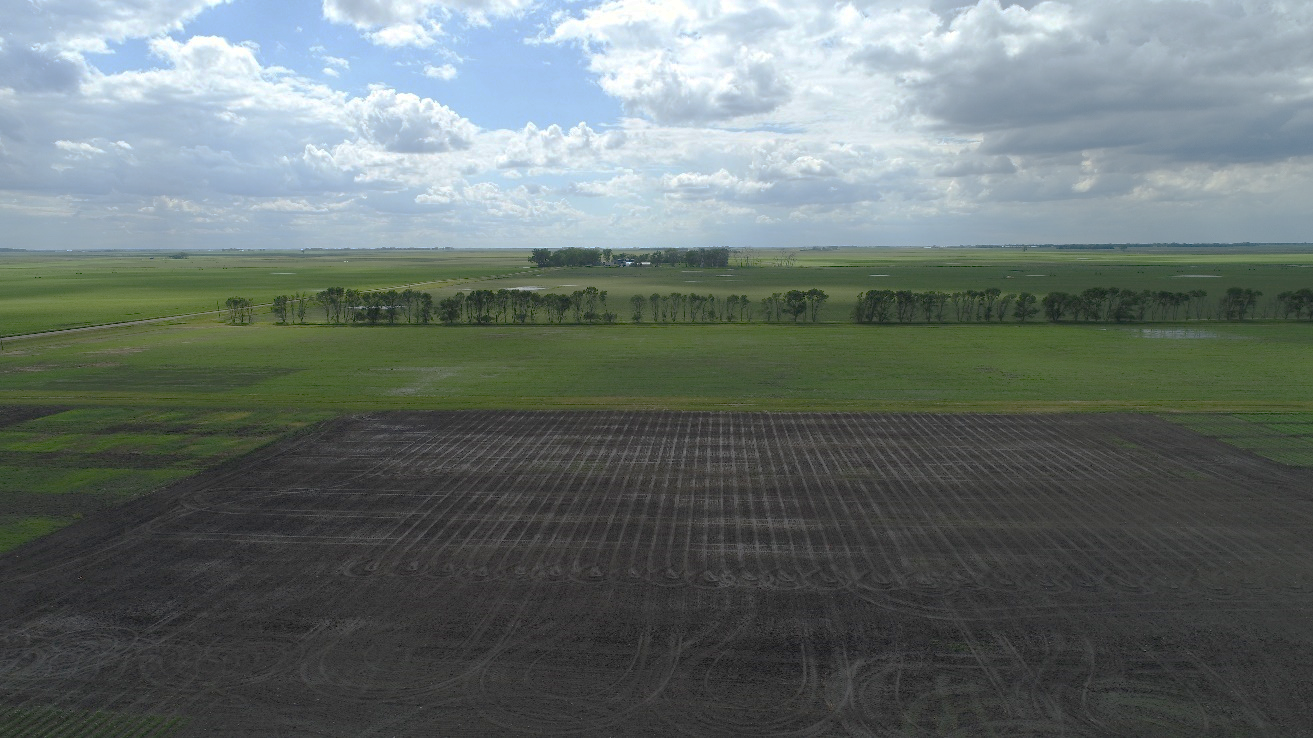
If your goal is to use your drone for crop scouting, one option would be to fly low, at a safe altitude, and capture individual pictures with a high level of detail (like the one below). Once you have those pictures, you can download them to your laptop or desktop computer and look at them in more detail, zooming in and out. Can you see the holes in the leaves in the picture below?
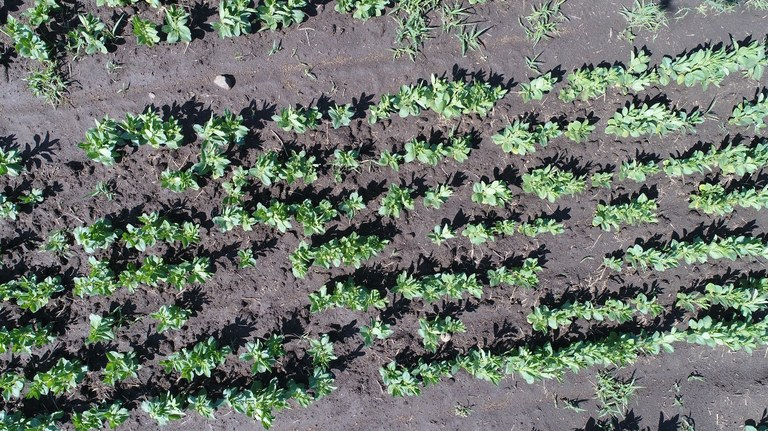 Faba beans – 20ft above ground level. Date 06/14/2017.
Faba beans – 20ft above ground level. Date 06/14/2017.
Did you find the holes in the leaves? If not, take a look on the right side of the picture, third row from the bottom, and 5-6 plants from the edge of the picture. Zoom in and try to find some other damaged leaves.
If you are interested in flying a large area, I would recommend much higher altitudes. As an example, I flew the area below (around 80 ac) at 270ft above ground. It took me around 23 minutes to do it (one battery) and I end up with 490 pictures from that field. So, what do you do with 490 pictures? Look through all of them one by one? In my office, I have a software that stitches all this pictures together to form a larger, single picture (orthomosaic). This larger picture is georeferenced, so we can find the exact location of each point on the orthomosaic using a GPS device or equipment that has a GPS receiver.
Carrington REC fields. Altitude 270ft above ground (around 80 acres).
I realize that most people do not have access to the software packages that I have, but there are options out there that would allow one to create orthomosaics from imagery captured with a drone. Cloud based services such as DroneDeploy (www.dronedeploy.com) and PrecisionMapper (http://www.precisionhawk.com/precisionmapper) are among the most popular drone image processing services and they offer free trial periods. After the trial period, one can keep using these services with some limitations.
Though flying a drone can be fun and exciting, I would encourage everyone to keep safety as a top priority. Drone crashes happen all the time, and yes, it can happen to you, too. I found this 10 minute video online “Drone Flying tips – 7 mistakes to avoid” (https://www.youtube.com/watch?v=eEKJq9tU85A) and I would encourage you to watch it before your next flight.
Safe flights everyone!!!
Paulo Flores, Ph.D.
paulo.flores@ndsu.edu
Precision Agriculture Specialist
+++
Just in case you could not find the holes in the faba bean leaves above, here is a closer look.
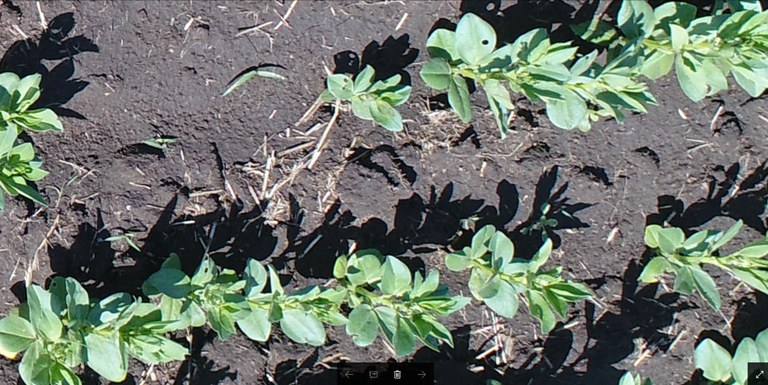
25 Years of Elbows, Farfalle and Wagon Wheels
Since biblical times, man has cultivated wheat for food and feed. Durum and spring wheat are and always have been important crops in North Dakota with the state being the nation’s leader in acreage and production. The CREC conducts a broad scope of research projects annually that are intended to sustain the viability of wheat and durum production for both farmers and associated business enterprises.
The specific durum or wheat variety a farmer plants represents a major determining factor as to the viability of the crop and ultimately the quantity and quality of grain available to processors and the consumer. The CREC conducts many variety trials and manages breeder nurseries for the NDSU durum and wheat plant breeders. These trials include commercially available cultivars and an extensive number of experimental lines with only a few to eventually merit release as varieties to farmers. The data collected helps to define differences in grain yield, disease tolerance, agronomic traits, and end use quality.
Beyond contributing toward variety improvement, the CREC research team conducts a series of research trials in wheat and durum that address managing pests, improving plant nutrition, optimizing inputs and refining cultural production practices. The CREC annually tests new cereal herbicide and fungicide products years before they are commercially released along with crop inputs including micronutrients and biological products. Plant nutrients such as nitrogen, phosphorus and sulfur are evaluated in wheat to improve both yield and economic performance. Production practices such as crop rotations and tillage systems, use of cover crops, varied seeding rates and remote sensing techniques are examples of research to help producers manage wheat to optimize the crops competitiveness.
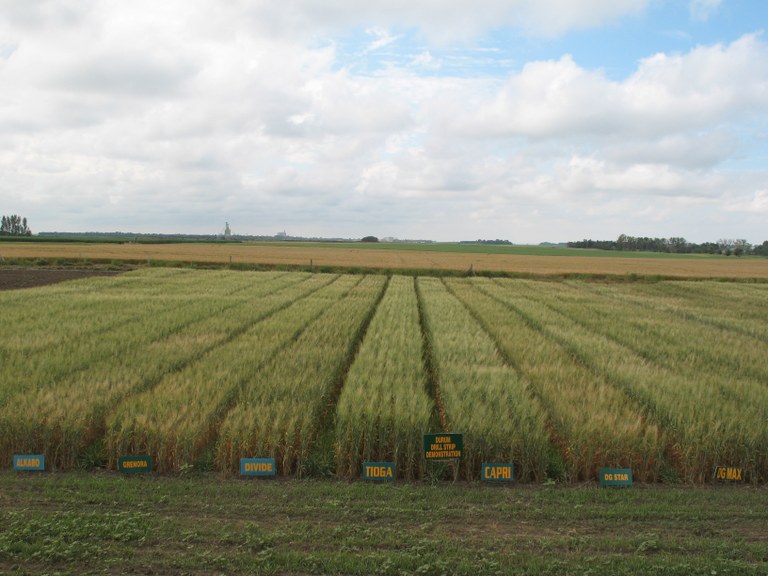
The CREC also conducts research on relatives of our common wheats, often referred to as “ancient grains”. Einkorn, emmer and spelt are evaluated under both organic and conventional environments. These wheat relatives are growing in demand and are utilized in many products including pasta. Durum variety trials conducted on certified organic land provide data to those farmers who sell into that market, which includes Dakota Growers Pasta Company.
As our neighbor, Dakota Growers Pasta Company celebrates 25 years of innovation in the pasta industry this summer. We’d like to congratulate them and wish them every success as they continue to provide a healthy market for durum and hard red spring wheat that our North Dakota farmers grow.
CREC Staff
Side-dressing Corn and Wheat
In this week’s Crop & Pest Report (https://www.ag.ndsu.edu/cpr), Dr. Franzen of NDSU wrote that high (but still within recommended rates) levels of pre-plant N fertilizer application on small grains does not cause yield reduction when crops experience drought later in the season. This is because adequate soil N enhances tillering and root growth, which consequently improves the crop’s ability to use water from a larger volume of soil.
Do we still need to side-dress corn or wheat even though we anticipate crop drought stress this summer?
Despite current shortage of rainfall in North Dakota, sub-soil moisture has been quite helpful in sustaining crop growth. If N side-dress is part of your spring fertility program, timing should depend on your goal to increase yield or grain protein.
- To enhance grain yield, consider stream-bar application of UAN between 4-leaf and jointing.
- To enhance protein, apply UAN immediately post-anthesis.
But what happens if I add N to my corn during a prevailing shortage of rainfall? Corn does not tiller, and has broader leaves than wheat.
Corn is more susceptible to drought stress due to evapotranspiration from its broad leaves. The current situation, however, does not yet prevent a farmer who had plans to side-dress N but is anticipating prolonged drought and crop stress.
Things to remember before side- or top-dressing corn
- In high-productivity, high-clay soils, side-dress N is encouraged. This is especially important for clay soils with high susceptibility of N denitrification when the soil is wet. N can be side-dressed with UAN using a coulter.
- On medium texture (loam, sandy-loam, loamy-sand, or silt loam) to sandy soils, anhydrous ammonia should be applied, 5-6 inches deep.
- Application can be made to every other row.
- If urea is to be used, consider urea that is coated with a proven commercial product like Agrotain® (or others with NBPT coating) to keep the N stable and minimize ammonia N loss for about 10 days. Apply as top-dress at < 100 lbs urea/ac (or 46 lbs N/ac).
- Recommended growth stage to side-dress corn in North Dakota is V5 to V6.
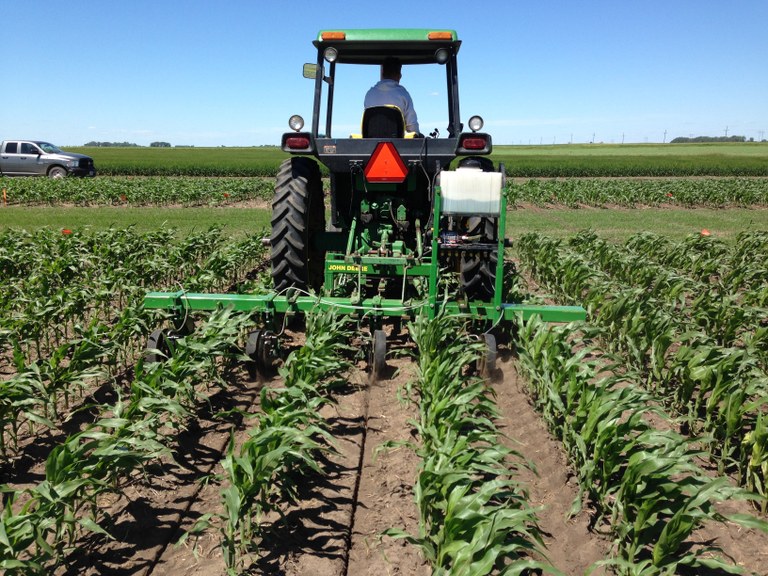
Acknowledgement of Dr. D. W. Franzen for permission to reference his article.
Jasper Teboh
Jasper.Teboh@ndsu.edu
Soil Scientist
Locking in Your Lamb Sale Price - Lamb LRP
Lamb producers used to have to take whatever the market price was on sale day. The cattle industry has price protection availability with the futures market through hedging and options. In addition, cattle have Livestock Risk Protection for protecting market prices. Recently, Livestock Risk Protection for Lambs (Lamb LRP) has become available.
Lamb LRP is a revenue insurance program that is reinsured and subsidized by the Federal Crop Insurance Corporation. Lamb LRP was first available in 2007 but was later discontinued. On April 24, 2017, Lamb LRP was again available for sale through participating crop insurance agents. A list of approved agents is at http://prodwebnlb.rma.usda.gov/apps/AgentLocator.
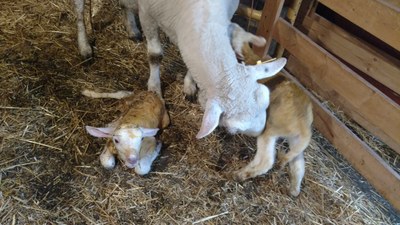
Newborn spring 2017 lambs.
A Lamb producer must submit a one-time application. Then a specific coverage endorsement (SCE) may be purchased for any number of lambs between 1 and 2000.
Multiple SCEs can be purchased as long as the total number of lambs price protected doesn’t exceed the number of lambs that you own. You also cannot sell the lambs any earlier than 30 days before the SCE matures or the SCE will be invalid. Also, once the SCE has matured you can purchase another SCE on the same lambs if applicable.
Lamb LRP is available every Monday between 10 a.m. – 7 p.m. CST except when Monday is a federal holiday, then it’s available on Tuesday. Lamb LRP is sold for 3 different maturity dates - 13, 26, and 39 weeks.
LRP coverage prices can be located at https://www.rma.usda.gov/tools/livestock.html. Lamb LRP prices are only found on Monday’s report. Lamb LRP are priced at 80, 85, 90, or 95% of the expected end value price. The premium amount increases as the coverage increases.
The LRP coverage price is subsided by Risk Management Agency to decrease the cost to the lamb producer.
For example:
- A producer has 45 lambs are to be marketed in November 2017. A Lamb LRP could have been purchased on May 22, 2017 for November 20, 2017. The lamb producer can sell the lamb any time after October 21, 2017.
- The expected end price for November 20, 2017 was $173.43. That date had four pricing options: 95% coverage at $164.759 for $7.119 per CWT, 90% at $156.087 for $4.166, 85% at $147.416 for $2.244 or 80% at $138.744 for $1.10.
- The 95% coverage was selected for lambs weighing 110#. The unsubsidized premium cost would be 110# at 7.119 per CWT or $7.83 per lamb. The 26 week subsidy is 35%. The net cost of the Lamb LRP is $5.09 per head.
- Lamb value is then set at $181.23 per head. If the market declines a payment will be made based off national prices and not the producer’s actual selling price.
Why consider lamb price protection? The Lamb LRP 95% coverage price on April 24, 2017 was $141.97 and on May 22, 2017 was $164.76. The lamb market rallied $22.79 per CWT.
Karl Hoppe, PhD
Karl.Hoppe@ndsu.edu
Area Extension Livestock Specialist


